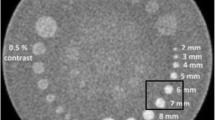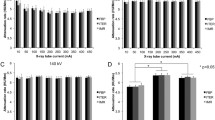Abstract
Computed tomography (CT) is a useful and widely employed imaging technique, which represents the largest source of population exposure to ionizing radiation in industrialized countries. Adaptive Statistical Iterative Reconstruction (ASIR) is an iterative reconstruction algorithm with the potential to allow reduction of radiation exposure while preserving diagnostic information. The aim of this phantom study was to assess the performance of ASIR, in terms of a number of image quality indices, when different reconstruction blending levels are employed. CT images of the Catphan-504 phantom were reconstructed using conventional filtered back-projection (FBP) and ASIR with reconstruction blending levels of 20, 40, 60, 80, and 100%. Noise, noise power spectrum (NPS), contrast-to-noise ratio (CNR) and modulation transfer function (MTF) were estimated for different scanning parameters and contrast objects. Noise decreased and CNR increased non-linearly up to 50 and 100%, respectively, with increasing blending level of reconstruction. Also, ASIR has proven to modify the NPS curve shape. The MTF of ASIR reconstructed images depended on tube load/contrast and decreased with increasing blending level of reconstruction. In particular, for low radiation exposure and low contrast acquisitions, ASIR showed lower performance than FBP, in terms of spatial resolution for all blending levels of reconstruction. CT image quality varies substantially with the blending level of reconstruction. ASIR has the potential to reduce noise whilst maintaining diagnostic information in low radiation exposure CT imaging. Given the opposite variation of CNR and spatial resolution with the blending level of reconstruction, it is recommended to use an optimal value of this parameter for each specific clinical application.








Similar content being viewed by others
References
European Commission (2014). Medical radiation exposure of the European population. Radiation Protection Report N° 180
National Council on Radiation Protection and Measurements (2009). Ionizing radiation exposure of the population of the United States. NCRP Report N° 160
McNitt-Gray MF (2002). AAPM/RSNA physics tutorial for residents: topics in CT. Radiation dose in CT. Radiographics 22(6):1541–1553
Willemink MJ, de Jong PA, Leiner T et al (2013) Iterative reconstruction techniques for computed tomography part 1: technical principles. Eur Radiol 23:1623–1631
Beister M, Kolditz D, Kalender WA (2012) Iterative reconstruction methods in X-ray CT. Phys Med 28(2):94–108
Argaud C (2012) ASIR™: a new reconstruction technique to lower dose without compromise. ASIR™ whitepaper. GE Healthcare, Waukesha, WI
Richard S, Husarik DB, Yadava G, Murphy SN, Samei E (2012) Towards task-based assessment of CT performance: system and object MTF across different reconstruction algorithms. Med Phys 39(7):4115–4122
Samei E, Richard S (2015) Assessment of the dose reduction potential of a model-based iterative reconstruction algorithm using a task-based performance metrology. Med Phys 42(1):314–323
Miéville FA, Gudinchet F, Brunelle F, Bochud FO, Verdun FR (2013) Iterative reconstruction methods in two different MDCT scanners: physical metrics and 4-alternative forced-choice detectability experiments—a phantom approach. Phys Med 2:99–110
Hussain FA, Mail N, Shamy AM, Alghamdi S, Saoudi A (2016) A qualitative and quantitative analysis of radiation dose and image quality of computed tomography images using Adaptive Statistical Iterative Reconstruction. J Appl Clin Med Phys 17(3):5903
Mangat J, Morgan J, Benson E, Bath M, Lewis M, Reilly A (2016) A study of the image quality of computed tomography adaptive statistical iterative reconstructed brain images using subjective and objective methods. Radiat Prot Dosim 169(1–4):92–99
Kim HG, Chung YE, Lee YH et al (2015) Quantitative analysis of the effect of iterative reconstruction using a phantom: determining the appropriate blending percentage. Yonsei Med J 56(1):253–261
The Phantom Laboratory (2013) Catphan ® 504 Manual. The Phantom Laboratory, New York, USA
Siewerdsen JH, Cunningham IA, Jaffray DA (2002) A framework for noise-power spectrum analysis of multidimensional images. Med Phys 29(11):2655–2671
Verdun FR, Racine D, Ott JG et al (2015) Image quality in CT: from physical measurements to model observers. Phys Med 31(8):8238–43
Friedman SN, Fung GSK, Siewerdsen JH, Tsui BMW (2013) A simple approach to measure computed tomography (CT) modulation transfer function (MTF) and noise-power spectrum (NPS) using the American College of Radiology (ACR) accreditation phantom. Med Phys 40(5):051907
Takenaga T, Katsuragawa S, Goto M, Hatemura M, Uchiyama Y, Shiraishi J (2015) Modulation transfer function measurement of CT images by use of a circular edge method with a logistic curve-fitting technique. Radiol Phys Technol 8:53–59
Tapiovaara MJ, Wagner RF (1993) SNR and noise measurements for medical imaging: I. A practical approach based on statistical decision theory. Phys Med Biol 38:71–92
Gardner SJ, Studenski MT, Giaddui T, Cui Y, Galvin J, Yu Y, Xiao Y (2014) Investigation into image quality and dose for different patient geometries with multiple cone-beam CT systems. Med Phys 41(3):031908
Atak H, Shikhaliev S (2015) Dual energy CT with photon counting and dual source systems: comparative evaluation. Phys Med Biol 60:8949–8975
Smith EA, Dillman JR, Goodsitt MM, Christodoulou EG, Keshavarzi N, Strouse PJ (2014). Model-based iterative reconstruction: effect on patient radiation dose and image quality in pediatric body CT. Radiology 270(2):526–534
Brady SL, Yee BS, Kaufman RA (2012) Characterization of Adaptive Statistical Iterative Reconstruction algorithm for dose reduction in CT: a pediatric oncology perspective. Med Phys 39(9):5520–5531
McCollough CH, Yu L, Kofler JM et al (2015) Degradation of CT low-contrast spatial resolution due to the use of iterative reconstruction and reduced dose levels. Radiology 276(2):499–506
Larsson J, Bath M, Ledenius K, Thilander-Klang A (2016) The effect of Adaptive Statistical Iterative Reconstruction on the assessment of diagnostic image quality and visualisation of anatomical structures in pediatric cerebral CT examinations. Radiat Prot Dosim 169(1–4):115–122
Larsson J, Bath M, Ledenius K, Caisander H, Thilander-Klang A (2016) Assessment of clinical image quality in pediatric abdominal CT examinations: dependency of the level of Adaptive Statistical Iterative Reconstruction (ASIR) and the type of convolution kernel. Radiat Prot Dosim 169(1–4):123–129
Yanagawa M, Honda O, Yoshida S et al (2010) Adaptive statistical iterative reconstruction technique for pulmonary CT: image quality of the cadaveric lung on standard- and reduced-dose CT. Acad Radiol 17(10):1259–1266
Geyer LL, Körner M, Harrieder A, Mueck FG, Deak Z, Wirth S, Linsenmaier U (2016) Dose reduction in 64-row whole-body CT in multiple trauma: an optimized CT protocol with iterative image reconstruction on a gemstone-based scintillator. Br J Radiol 89:20160003
Leipsic J, LaBounty TM, Heilbron B, Min JK, Mancini J, Lin FY, Taylor C, Dunning A, Earls JP (2010) Adaptive Statistical Iterative Reconstruction: assessment of image noise and image quality in coronary CT angiography. Am J Roentgenol 195(3):649–654
Patro SN, Chakraborty S, Sheikh A (2016) The use of Adaptive Statistical Iterative Reconstruction (ASIR) technique in evaluation of patients with cervical spine trauma: impact on radiation dose reduction and image quality. Br J Radiol 89:20150082
Geyer LL, Schoepf UJ, Meinel FG et al (2015) State of the art: iterative CT reconstruction techniques. Radiology 276(2):339–357
Dodge CT, Tamm EP, Cody DD, Liu X, Jensen CT, Wei W, Kundra V, Rong XJ (2015) Performance evaluation of iterative reconstruction algorithms for achieving CT radiation dose reduction—a phantom study. J Appl Clin Med Phys 17(2):511–531
Li G, Liu X, Dodge CT, Jensen CT, Rong XJ (2016) A noise power spectrum study of a new model-based iterative reconstruction system: Veo 3.0. J Appl Clin Med Phys 17(5):428–439
Gulliksrud K, Stokke C, Martinsen ACT (2014) How to measure CT image quality: Variations in CT-numbers, uniformity and low contrast resolution for a CT quality assurance phantom. Phys Med 30:521–526
Li B, Yadava Y, Hsieh J (2015) Quantification of head and body CTDI VOL of dual-energy X-ray CT with fast-kVp switching. Med Phys 38(5):2595–2601
Price RG, Vance S, Cattaneo R, Schultz L, Elshaikh MA, Chetty IJ, Glide-Hurst CK (2014) Characterization of a commercial hybrid iterative and model-based reconstruction algorithm in radiation oncology. Med Phys 41(8):081907
Zhang D, Li X, Liu B (2011) Objective characterization of GE discovery CT750 HD scanner: gemstone spectral imaging mode. Med Phys 38(3):1178–1188
Brunner CC, Kyprianou IS (2013) Material-specific transfer function model and SNR in CT. Phys Med Biol 58:7447–7461
Sande EPS, Martinsen ACT, Hole EO, Olerud HM (2010) Interphantom and interscanner variations for Hounsfield units—establishment of reference values for HU in a commercial QA phantom. Phys Med Biol 55:5123–5135
Mozejko D, Andersen HK, Pedersen M, Waaler D, Martinsen ACT (2016) Image texture and radiation dose properties in CT. J Appl Clin Med Phys 17(3):408–418
Acknowledgements
We would like to thank Prof. Duccio Volterrani, Dr. Antonio Traino and Dr. Davide Giustini for supporting this work. Also, the authors are grateful to the anonymous Reviewers for constructive and helpful comments to improve the manuscript.
Author information
Authors and Affiliations
Corresponding author
Ethics declarations
Conflict of interest
The authors declare that they have no conflict of interest.
Ethical approval
Given that our study is a phantom study, the ethical approval statement is not needed/applicable.
Rights and permissions
About this article
Cite this article
Barca, P., Giannelli, M., Fantacci, M.E. et al. Computed tomography imaging with the Adaptive Statistical Iterative Reconstruction (ASIR) algorithm: dependence of image quality on the blending level of reconstruction. Australas Phys Eng Sci Med 41, 463–473 (2018). https://doi.org/10.1007/s13246-018-0645-8
Received:
Accepted:
Published:
Issue Date:
DOI: https://doi.org/10.1007/s13246-018-0645-8




